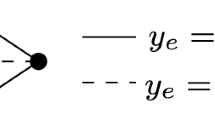Abstract
A comprehensive class of cutting planes for the symmetric travelling salesman problem (TSP) is proposed which contains the known “comb inequalities”, the “path inequalities” and the “3-star constraints” as special cases. Its relation to the “clique tree inequalities” is discussed. The cutting planes are shown to be valid for a relaxed version of the TSP, the travelling salesman problem on a road network, and—under certain conditions—to define facets of the polyhedron associated with this problem.
Similar content being viewed by others
References
G. Cornuéjols, J. Fonlupt and D. Naddef, “The graphical travelling salesman problem and some related integer polyhedra,” Research Rep. 378, Lab. d'Informatique et de Math. Appl. de Grenoble, May 1983.
G. Cornuéjols, J. Fonlupt and D. Naddef, “The travelling salesman problem on a graph and some related integer polyhedra,”Mathematical Programming 33 (1985) 1–27.
H. Crowder and M.W. Padberg, “Solving large-scale symmetric travelling salesman problems to optimality,”Management Science 26 (1980) 495–509.
B. Fleischmann, “Distance conserving reductions for non-oriented networks,”OR Spektrum 5 (1983) 195–205.
B. Fleischmann, “A cutting plane procedure for the travelling salesman problem on road networks,”European Journal of Operations Research 21 (1985) 307–317.
M. Grötschel, “On the symmetric travelling salesman problem: Solution of a 120-city problem,”Mathematical Programming Studies 12 (1980) 61–77.
M. Grötschel and M.W. Padberg, “On the symmetric travelling salesman problem I: Inequalities,”Mathematical Programming 16 (1979) 265–280.
M. Grötschel and M.W. Padberg, “Polyhedral theory,” in: E.L. Lawler et al., eds.,The Travelling Salesman Problem (J. Wiley & Sons, 1985), pp. 251–305.
M. Grötschel and W.R. Pulleyblank, “Clique tree inequalities and the travelling salesman problem,” to appear inMathematics of Operations Research.
A. Land, “The solution of some 100-city travelling salesman problems,” Report, London School of Economics 1979.
G. Laporte and Y. Nobert, “A cutting planes algorithm for the n-salesman problem,”Journal of the Operational Research Society 31 (1980) 1017–1023.
P. Miliotis, “Using cutting planes to solve the symmetric travelling salesman problem,”Mathematical Programming 15 (1978) 177–188.
P. Miliotis, G. Laporte and Y. Nobert, “Computational experience of two methods for finding the shortest complete cycle or circuit in a graph,”RAIRO 15 (1981), 233–239.
M.W. Padberg and S. Hong, “On the symmetric travelling salesman problem: A computational study,”Mathematical Programming Studies 12 (1980) 78–107.
A. Volgenant, R. Jonker and G.A.P. Kindervater, “A note on finding a shortest complete cycle in an undirected graph,”European Journal of Operations Research 23 (1986) 82–85.
L.A. Wolsey, “Heuristic analysis, linear programming and branch and bound,”Mathematical Programming Studies 13 (1980) 121–134.
Author information
Authors and Affiliations
Rights and permissions
About this article
Cite this article
Fleischmann, B. A new class of cutting planes for the symmetric travelling salesman problem. Mathematical Programming 40, 225–246 (1988). https://doi.org/10.1007/BF01580734
Received:
Revised:
Issue Date:
DOI: https://doi.org/10.1007/BF01580734




